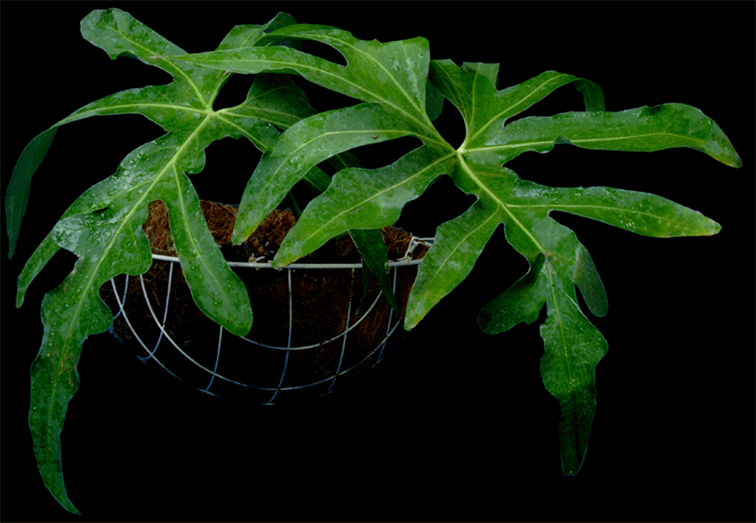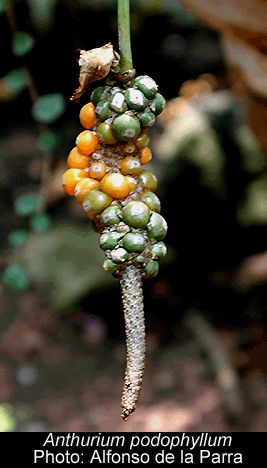![]()
Aroids and other genera in the Collection
Take the Tour Now?
Orchids
The
Exotic Rainforest
Plants in
the Exotic Rainforest Collection
The images on this website are copyright protected. Please contact us before any reuse.
Detailed information on Growing Anthurium Species
Click this Link
Looking for a specimen? Contact
http:///
![]()
Within our collection we have many species of Anthurium. If you are seeking other photos, click this link:

Synonyms: Pothos laciniatus, Anthurium polytomum, Anthurium polytomum,
Anthurium pseudopodophyllum, Anthurium ghiesbreghtii, Anthurium membranuliferum
An unusually
formed Anthurium, Anthurium podophyllum (pod-o-PHI-lum)
has "frilly" leaves mounted atop long petioles. Those petioles
are often known to collectors as "stems". Found in nature near
Veracruz and Oaxaca in tropical Mexico.
 A. podophyllum
is endemic along Mexico's Atlantic (Gulf of Mexico) coast. An
endemic species is one that is exclusively found in one region.
Anthurium podophyllum normally lives at elevations of 750 to
2,000 meters (approximately 2,400 to 6,000 feet). Anthurium
podophyllum has the ability to grow as either an epiphyte (ep-a-FIT) on
the sides and branches of trees or as a terrestrial plant form in
the earth and is most often found as a terrestrial species.
However, Anthurium podophyllum is sometimes epipetric.
Epipetric species are those capable of growing attached to stone.
The blades are capable of standing one meter in
height (approximately 3 feet) with a leaf span of roughly equal
measurement. A. podophyllum is placed in Anthurium
section Schizoplacium. Anthurium species are known to
be highly variable and not every leaf of every specimen will always
appear the same. This link explains in greater detail the
scientific principle of natural variation and morphogenesis.
Click here.
A. podophyllum
is endemic along Mexico's Atlantic (Gulf of Mexico) coast. An
endemic species is one that is exclusively found in one region.
Anthurium podophyllum normally lives at elevations of 750 to
2,000 meters (approximately 2,400 to 6,000 feet). Anthurium
podophyllum has the ability to grow as either an epiphyte (ep-a-FIT) on
the sides and branches of trees or as a terrestrial plant form in
the earth and is most often found as a terrestrial species.
However, Anthurium podophyllum is sometimes epipetric.
Epipetric species are those capable of growing attached to stone.
The blades are capable of standing one meter in
height (approximately 3 feet) with a leaf span of roughly equal
measurement. A. podophyllum is placed in Anthurium
section Schizoplacium. Anthurium species are known to
be highly variable and not every leaf of every specimen will always
appear the same. This link explains in greater detail the
scientific principle of natural variation and morphogenesis.
Click here.
As an epiphyte the roots of Anthurium podophyllum cascade impressively down the side of it's host tree. The plant's pinnate lobed leaves are quite coriacious (leathery) and have the unusual texture of living cardboard. The growth form resembles Philodendron bipinnatifidum in that it is pinnatified however, other than both being aroids, there is no relationship. The leaf blades stand erect. The petiole is "D" shaped if cut as a cross section. The adaxial (upper) surface of the leaf blade is glossy while the lower surface is semi-glossy. The larger the plant grows the more pinnatified (branched) the leaves become.
Anthurium differ from Philodendron species since all Anthurium produce perfect flowers containing both male and female organs while Philodendron produce imperfect flowers containing only a single sex. When an Anthurium is "in flower" the reference is to the tiny flowers containing both male and female sexual parts that grow on the spadix at the center of the inflorescence. To help prevent self pollination nature has designed the female flowers to be receptive before the male portion of the flower produce their pollen so in most cases an insect must bring pollen from another plant. For more information on the sexual reproduction of any aroid click the pollination link below.
The inflorescence hangs pendent while the peduncle that supports the inflorescence measures 38 to100cm in length. The petiole is terete (cylindrical) in shape. Once pollinated the berries produced are a dull orange and obovoid in shape. The photo to the right of a spathe and spadix shows a specimen with berries that have not fully matured.
The plant appreciates typical tropical rain forest conditions and grows well in slightly cooler temperatures. It does not appreciate being allowed to dry out but it also does not appreciate being kept soaking wet. As a result, we use a well draining moisture control soil mixture with a healthy helping of peat, Perlite and orchid potting medium containing charcoal, bark and gravel added.
A truly impressive plant for those who appreciate unusual leaf forms. In late 2006, our specimen measured 56cm (22 inches) high by 53cm (21 inches) wide at the widest point.
Aroid Pollination!
As
it occurs in nature and by any horticulturist
Join the
International Aroid Society:
http://www.exoticrainforest.com/Join%20IAS.html